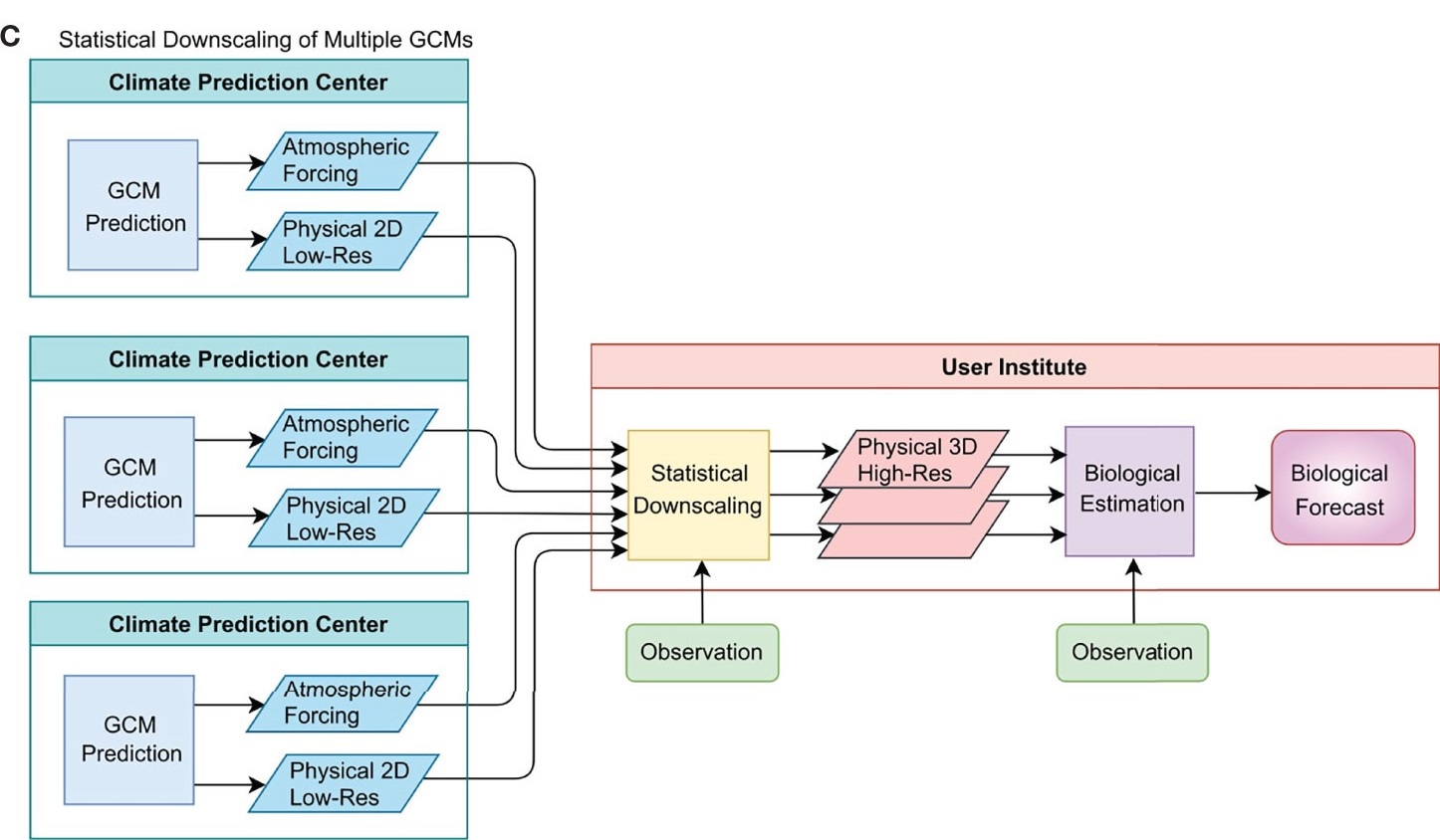Towards Regional Marine Ecological Forecasting Using Global Climate Mode Predictions From Subseasonal to Decadal Time Scales: Bottlenecks and Recommendations

FIGURE 1 | A workflow of eiological forecasts based on multiple physical GCM predictions with statistical downscaling. The squares indicate systems that produce predictions, downscaling or biological estimation, whereas the parallelograms indicate the outputs from the systems. The stacked parallelograms in the middle of the panel indicate downscaling of different GCM predictions. The other workflows staring from a single physical GCM prediction with dynamical or statistical downscaling were also discussed in the paper. Downscaling can be skipped if GCM predictions are of adequate resolution and acceptable bias. .
Motivated by a number of ecological and socioeconomic aims, such as fisheries and aquaculture management, biodiversity conservation and protection of human health, marine ecological forecasting is an emerging research area that has attracted significant attention from the global community, including CLIVAR and PICES. A perspective paper discussing how the research community can enhance development of marine ecosystem forecasting using physical ocean conditions predicted by the global climate models (GCMs) has recently been published in Frontiers in Marine Science (Minobe et al. 2022, doi: 10.3389/fmars.2022.855965) as part of the collection on ‘North Pacific Climate and Ecosystem Predictability on Seasonal to Decadal Timescales’, a key outcome from the CLIVAR/PICES joint Working Group on ‘Climate and Ecosystem Predictability’. The perspective paper reviews the major ongoing activities related to climate predictions at subseasonal to decadal lead times and outlines new research opportunities for marine ecosystem forecasting. Dr. Shoshiro Minobe, Dr. Antonietta Capotondi and Dr. Ryan Rykaczewski from the CLIVAR community led or contribute to the paper.
Forecasting the marine ecosystem using physical predictions consists of a multi-step process, typically including (1) a GCM prediction, (2) the dynamical or statistical downscaling of the GCM field, and (3) biological estimation (See Figure 1). The availability of oceanic prediction data is identified as a limitation for the forecast applications, thus the paper suggests that operational centers and prediction projects increase the range of ocean data available to the public (e.g., starting with the expansion of their output to additional 2D variables which require much smaller storage than 3D variables), as well as enabling forecast output to be downloaded for a selected region rather than the whole globe.
According to the perspective paper, future studies to advance the marine ecological forecasting can be broadly divided into two main categories: physical downscaling and biological prediction. On the physical aspect, the authors suggest that the skill of GCM predictions be examined for various ecological oceanic variables important in marine biology in order to improve ecological forecasts. Furthermore, physical predictions from large ensembles and multi-model ensembles should be examined for their use in ecological predictions. In addition, as the resolution of global ocean models may not be sufficient for regional marine ecosystem prediction efforts, dynamical or statistical downscaling of the predicted data to higher resolutions are necessary. Meanwhile, on the biological aspects, it is important to identify which variables are promising targets for prediction, and the prediction skill for potential marine ecosystem targets should be assessed by conducting retrospective forecasts evaluated against observations. Lessons learned from climate reforecasts can be useful to guide similar efforts for biological reforecasts. Moreover, an understanding of the underlying ecological mechanisms responsible for the empirical relationships between physical and biological properties and how those mechanisms may change over time is necessary to increase the confidence in ecological predictions.
At the end of the paper, the authors also suggest establishing a set of case studies for biological predictions with clear application to society (e.g. by choosing specific climate and biological events as prediction targets) distributed across the global ocean, to improve coordination at both regional and international scales, as well as to advance our capacity to fulfil the gola of ‘A Predicted Ocean’, one of the desired outcomes for the UN Decade of Ocean Science for Sustainable Development (2021-2030).
(Summary written by Jing Li)
****************************************
Minobe S, Capotondi A, Jacox MG, Nonaka M and Rykaczewski RR (2022) Toward Regional Marine Ecological Forecasting Using Global Climate Model Predictions From Subseasonal to Decadal Timescales: Bottlenecks and Recommendations. Front. Mar. Sci. 9:855965. doi: 10.3389/fmars.2022.855965














Add new comment